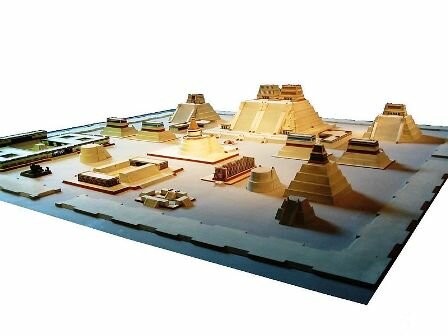One of these following facts about Tenochtitlan might give you much information about this history. Tenochtitlan was an Aztec city-state located on an island in Lake Texcoco, in the Valley of Mexico. Founded in 1325, it became the capital of the expanding Mexica Empire in the 15th century, until captured by the Spanish in 1521. At its peak, it was the largest city in the Pre-Columbian Americas. When paired with Mexico, the name is a reference to Mexica, also known as “Aztecs” although they referred to themselves as Mexica. It subsequently became a cabecera of the Viceroyalty of New Spain. Today the ruins of Tenochtitlan are located in the central part of Mexico City. To get to know more information about this city-state, here are some other facts about Tenochtitlan you might be interested in.
Facts about Tenochtitlan 1: Name
Traditionally, its name was thought to come from Nahuati tetl (“rock”) and n?chtli (“prickly pear”) and is often thought to mean “Among the prickly pears [growing among] rocks”. However, one attestation in the late 16th-century manuscript known as “the Bancrot dialogues” suggest the second vowel was short, so that the true etymology remains uncertain.
Facts about Tenochtitlan 2: City Plan
The city was divided into four zones or campan, each campan was divided on 20 districts, and each calpulli, or ‘big house’, was crossed by streets or tlaxilcalli. There were three main streets that crossed the city, each leading to one of the three causeways to the mainland of Tepeyac, Ixtapalpa, and Tlacopan.
Facts about Tenochtitlan 3: Marketplace
Each calpulli meaning “large house” had its own tiyanquiztli (marketplace), but there was also a main marketplace in Tlatelolco, Tenochtitlan’s sister city.
Facts about Tenochtitlan 4: Public Buildings
In the center of the city were the public buildings, temples and prostis. Inside a walled square, 300 meters to a side, was the ceremonial center. There were about 45 public buildings including: the Templo Mayor, which dedicated to the Aztec patron deity Huitzilopochtli and the Rain God Tlaloc, the temple of Quetzalcoatl, the ball-game court with the rack of skulls, the Sun Temple, which was dedicated to Tonatiuh, the Eagle’s House, which was associated with warriors and the ancient power of rulers, the platforms for the gladiatorial sacrifice, and some minor temples.
Facts about Tenochtitlan 5: Palace of Moctezuma II
The palace of Moctezuma II also had two houses or zoos, one for birds of prey and another for other birds, reptiles and mammals. About 300 people were dedicated to the care of the animals. There was also a botanical garden and an aquarium. The aquarium had ten ponds of salt water and ten ponds of fresh water, containing fish and aquatic birds.
Facts about Tenochtitlan 6: History
Tenochtitlan was the capital city of the Mexican civilization, consisting of the Mexica people, founded in 1325. The state religion of the Mexica civilization awaited the fulfillment of an ancient prophecy: that the wandering tribes would find the destined site for a great city whose location would be signaled by an Eagle eating a snake while perched atop a cactus.
Facts about Tenochtitlan 7: Social Classe
Tenochtitlan can be considered the most complex society in Mesoamerica in regards to social stratification. The highly complex system involves many social classes: macehualtin, pipiltin, cuauhipiltin, tetuhctin and pochteca.
Facts about Tenochtitlan 8: Ruins
Tenochtitlan’s main temple complex, the Templo Mayor, was dismantled and the central district of the Spanish colonial city was constructed on top of it. The great temple was destroyed by the Spanish during the construction of a cathedral. The location of the Templo Mayor was rediscovered in the early 20th century, but major excavations did not take place until 1978–1982, after utility workers came across a massive stone disc depicting the nude dismembered body of the moon goddess Coyolxauhqui.
Facts about Tenochtitlan 9: Human Bones
In August 2012, archaeologists discovered a mix of 1,789 human bones five metres below street level in Mexico City.The burial dates back to the 1480s and lies at the foot of the main temple in the sacred ceremonial precinct of the Aztec capital. The bones are from children, teenagers and adults and a complete skeleton of a young woman was also found at the site.
Facts about Tenochtitlan 10: Novels
Huesos de Lagartija, a novel by Federica Narrete, tells the story of a young Aztec who lived through the European invasion of Mexico. The novel has many details about daily life in Tenochtitlán.
Hope you would find those Tenochtitlan facts really interesting and useful for your additional reading.










 www.PortlandPayday.Loans
www.PortlandPayday.Loans